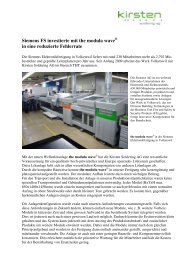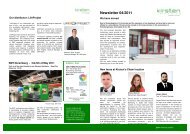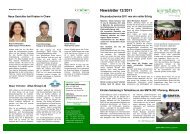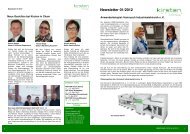the Modula Wave® Solder Extraction System - Kirsten Soldering AG
the Modula Wave® Solder Extraction System - Kirsten Soldering AG
the Modula Wave® Solder Extraction System - Kirsten Soldering AG
You also want an ePaper? Increase the reach of your titles
YUMPU automatically turns print PDFs into web optimized ePapers that Google loves.
2<br />
Newsletter 01/2012<br />
EU-Directive 2002/95/EC<br />
EU Directive 2002/95/EC, better known in its short form<br />
RoHS (Restriction of (<strong>the</strong> use of certain) Hazardous<br />
Substances), which came into force on July 1, 2006,<br />
defines <strong>the</strong> permissible maximum concentrations of<br />
hazardous substances in homogenous materials used<br />
in electronic and electrical equipment.<br />
A maximum permissible concentration of 0.1% by<br />
weight was prescribed for lead, mercury, hexavalent<br />
chromium, polybrominated biphenyles (PBB) and<br />
polybrominated diphenyle<strong>the</strong>r (PBDE) and 0.01% by<br />
weight for cadmium. To prevent <strong>the</strong> new directive from<br />
negatively affecting safety and industrial areas, a<br />
comprehensive catalogue describing a wide range of<br />
exceptions was compiled. Most exceptions have/had<br />
an expiry date indicating when corresponding products<br />
are no longer allowed to contain <strong>the</strong> listed hazardous<br />
substances. The most prominent example was<br />
automotive electronics, for which <strong>the</strong> RoHS exception<br />
expired on January 1, 2011.<br />
New legislation, Directive 2011/65/EU, also known as<br />
RoHS 2, abolishes <strong>the</strong> following exceptions as laid<br />
down in Directive 2002/95/EC:<br />
Area Expiry date of <strong>the</strong> exceptional rules<br />
Medical equipment July 22, 2014<br />
In-vitro diagnostics July 22, 2016<br />
Monitoring and control instruments July 22, 2016<br />
Industrial monitoring and control instruments July 22, 2017<br />
Implanted active medical equipment scheduled for review in 2020<br />
All o<strong>the</strong>r electrical and electronic equipment July 22, 2019<br />
The directive of RoHS 2 will particularly affect lead as a<br />
soldering constituent or metallic elements. The product<br />
families, which must now be soldered without lead,<br />
have to be reliable. This also raises concerns regarding<br />
reliable operation and corresponding process problems<br />
(lead-free soldering has small process windows).<br />
<strong>Kirsten</strong> <strong>Solder</strong>ing <strong>AG</strong> has extensive expertise in <strong>the</strong><br />
field of process adjustment and is <strong>the</strong>refore able to<br />
actively support customers and prospects to this end.<br />
Tips and Tricks for wave soldering<br />
Find <strong>the</strong> correct transport direction through wave<br />
Wave soldering of SMD’s<br />
The right design of a PCB in every soldering process is<br />
very important. Sometimes small adjustments can lead<br />
to a much better soldering result.<br />
Unfortunately most of process specialists<br />
have no or only small influence on <strong>the</strong><br />
design. However a rotation of <strong>the</strong> PCB and<br />
o<strong>the</strong>r consideration can reduce <strong>the</strong> amount<br />
of soldering defects.<br />
The defects rate on wave soldered of<br />
SMD’s is strongly influenced by <strong>the</strong> direction<br />
on which <strong>the</strong>y are transported through <strong>the</strong><br />
wave. The following figures show <strong>the</strong> known<br />
orientation for certain SMD’s.<br />
Fur<strong>the</strong>r details can be obtained from EU Directive<br />
2011/65/EU, which is available online:<br />
German: http://eur-lex.europa.eu/de/index.htm<br />
English: http://eur-lex.europa.eu/en/index.htm<br />
French: http://eur-lex.europa.eu/fr/index.htm<br />
The basic rules are:<br />
- Avoid solder bridges formation with <strong>the</strong> shown<br />
tranpsort direction<br />
- <strong>Solder</strong> smaller prior to larger components to<br />
avoid shadow effects<br />
“<strong>the</strong> <strong>Modula</strong> Wave ® <strong>Solder</strong> <strong>Extraction</strong> <strong>System</strong>” by <strong>Kirsten</strong><br />
<strong>Kirsten</strong> has developed <strong>the</strong> new vortex jet wave ® with a bigger solder pot capacity, meaning that solder volume has<br />
increased from 60 kg to 180 kg. Thus manual draining of solder on bigger solder volume will be a hassle, that’s<br />
why we developed a new system, "<strong>the</strong> modula wave ® solder extraction system“, to ease our customer on <strong>the</strong><br />
solder draining process.<br />
This "<strong>the</strong> modula wave ® solder extraction system“, is used to collect molten solder from <strong>the</strong> solder pot outlet in an<br />
aluminium mould (cavity) and <strong>the</strong>refore producing reusable solder bars.<br />
.<br />
Picture A: “<strong>the</strong> modula wave ® solder extraction<br />
system”<br />
Once <strong>the</strong> first cavity is full, <strong>the</strong> solder is <strong>the</strong>n moved<br />
to <strong>the</strong> next empty cavity by manually turning <strong>the</strong><br />
rotating handle. This system is also equipped with a<br />
compressed air cooling system which is used to<br />
solidify <strong>the</strong> solder in each cavity. That is <strong>the</strong> way<br />
how <strong>the</strong> whole alloy of molten solder is easily<br />
drained out by producing reusable solder bars.<br />
A<br />
B<br />
Picture D: Solidified and cooled solder bar<br />
Picture B: Molten solder flowing through a stainless<br />
steel gutter to fill up cavity.<br />
Picture C: Molten solder solidified after cooling<br />
down by air<br />
The benefit of this solder extraction system is to allow customer to change quickly <strong>the</strong> solder alloy type when <strong>the</strong>re<br />
is a request from <strong>the</strong>ir end customer or during replacing <strong>the</strong>ir old wave solder machine by re-use <strong>the</strong> alloy inside <strong>the</strong><br />
solder pot. By using “<strong>the</strong> modula wave ® solder extraction system”, customer can perform by <strong>the</strong>ir own <strong>the</strong> change<br />
of <strong>the</strong> solder alloy type without needing to engage third party to drain <strong>the</strong> alloy as what is practice by our<br />
competitors.<br />
On top of that, “<strong>the</strong> modula wave ® solder extraction system” provides more safety concern concept where<br />
everything is mechanically engineered which makes it robust. The solidified solder bar can easily be retrieved as a<br />
top up solder when needed compare to dumping <strong>the</strong> alloy into a bin and send it to third party to cut into small<br />
pieces in order to re-use.<br />
In addition, <strong>the</strong> “<strong>the</strong> modula wave ® solder extraction system” is using compressed air as a cooling media which <strong>the</strong><br />
air outlet is located at modular wave out conveyor, this eliminates additional electrical connection.<br />
D<br />
C<br />
green wave soldering systems<br />
D<br />
3






